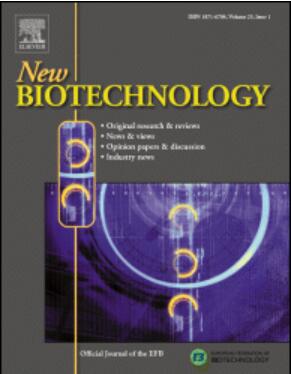Improving PHB production in cyanobacteria: Modeling the optimal light regime for growth
IF 4.9
2区 生物学
Q1 BIOCHEMICAL RESEARCH METHODS
引用次数: 0
Abstract
The production of bioplastics, such as polyhydroxybutyrate (PHB), using cyanobacteria offers a sustainable alternative to conventional plastics. However, achieving economically viable production requires optimizing biomass growth. This study examined four growth models: Gompertz (empirical growth), Baranyi-Roberts (biologically dependent), Monod (nutrient dependent), and Aiba (irradiance dependent). The results indicate that a light-based model more accurately describes cyanobacterial growth and shows potential for optimizing light regimes. Additionally, an estimator was proposed to assess the potential PHB yield within the given biomass. Experiments were conducted to correlate photosynthetic efficiency with biomass production, providing deeper insights into the effects of light on growth. These findings support the development of optimized cultivation strategies, ultimately improving the economic viability of cyanobacteria-based bioplastics.

提高蓝藻中PHB的生产:模拟生长的最佳光照制度。
利用蓝藻生产生物塑料,如聚羟基丁酸酯(PHB),为传统塑料提供了一种可持续的替代品。然而,实现经济上可行的生产需要优化生物质增长。本研究检验了四种生长模型:Gompertz(经验增长)、Baranyi-Roberts(生物依赖)、Monod(营养依赖)和Aiba(辐照依赖)。结果表明,基于光的模型更准确地描述了蓝藻的生长,并显示出优化光照制度的潜力。此外,还提出了一个估算器来评估给定生物量内PHB的潜在产量。进行了将光合效率与生物量生产联系起来的实验,为光对生长的影响提供了更深入的见解。这些发现支持优化培养策略的发展,最终提高蓝藻生物塑料的经济可行性。
本文章由计算机程序翻译,如有差异,请以英文原文为准。
求助全文
约1分钟内获得全文
求助全文
来源期刊

New biotechnology
生物-生化研究方法
CiteScore
11.40
自引率
1.90%
发文量
77
审稿时长
1 months
期刊介绍:
New Biotechnology is the official journal of the European Federation of Biotechnology (EFB) and is published bimonthly. It covers both the science of biotechnology and its surrounding political, business and financial milieu. The journal publishes peer-reviewed basic research papers, authoritative reviews, feature articles and opinions in all areas of biotechnology. It reflects the full diversity of current biotechnology science, particularly those advances in research and practice that open opportunities for exploitation of knowledge, commercially or otherwise, together with news, discussion and comment on broader issues of general interest and concern. The outlook is fully international.
The scope of the journal includes the research, industrial and commercial aspects of biotechnology, in areas such as: Healthcare and Pharmaceuticals; Food and Agriculture; Biofuels; Genetic Engineering and Molecular Biology; Genomics and Synthetic Biology; Nanotechnology; Environment and Biodiversity; Biocatalysis; Bioremediation; Process engineering.
 求助内容:
求助内容: 应助结果提醒方式:
应助结果提醒方式:


